We Can Work It Out: design and mobile working
Text by Simon Keane-Cowell
Zürich, Switzerland
21.09.10
October sees the 2010 installment of Orgatec in Cologne, the leading international design fair for office and work environments. In spite of the death knell being sounded some time ago for the traditional, fixed-location office, it's still with us. Nonetheless, increasing numbers of people, thanks to rapid advances in wireless technology, are breaking free from their desks and taking to the road, working wherever they happen to pitch up. Architonic takes a look at a number of environments and products that respond – and further – this social trend.
Do you have one yet? The new iPhone, that is? As someone who doesn't even possess an old one, I'm not going to start rhapsodising about this new piece of kit's amazing capabilities – although I am an admirer of what British industrial designer Jonathan Ive has done at Apple during his time there as design chief. The formal language he has developed for the company's products – whose visual and tactile beauty has recast our relationship with things electronic, making it a lot more of an emotional one – has been likened to that of design legend Dieter Rams's work and quite rightly so.
The antithesis of the traditional office: Soho House New York's Drawing Room is designed for digital nomads to set up temporary work camp in style. Cocktails aid work efficiency.
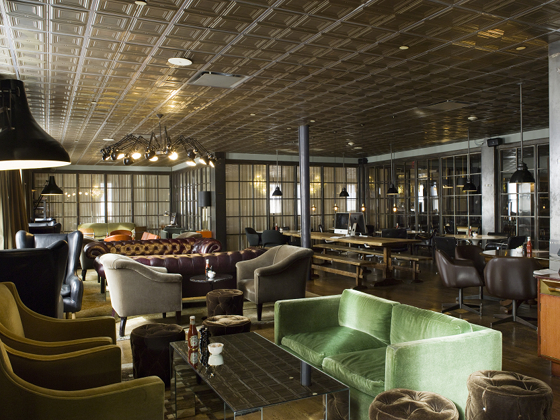
The antithesis of the traditional office: Soho House New York's Drawing Room is designed for digital nomads to set up temporary work camp in style. Cocktails aid work efficiency.
×Apple's latest offering serves to remind us not only of the pace at which digital technology is changing, but also of the social effects of such change. One activity that most of us engage with on a regular, if not almost daily, basis, and which has undergone a technology-driven shift in the way it operates is that of work. The increased availability and performance of mobile-communication channels and ways of sharing data have served to trouble the idea of the office as a fixed, physical location, housing a team of workers.
Yet, in spite of a number of Cassandras heralding the death of the office over the past few years, it doesn't look like we're quite ready yet to give up on concept of work involving to a large extent a static, geographically locatable space. The advent of instant global connectivity (or, rather, the illusion that it's instantaneous) notwithstanding, there is still currency in notion that a singular, shared space somehow reflects a unity of organisational vision.
The Sitting Room at Shoreditch House (part of the Soho House chain) offers a considered environment for members who feel like working. Carefully selected furniture, like Tom Dixon's 'Wingback' chairs, provide privacy, while still allowing social contact
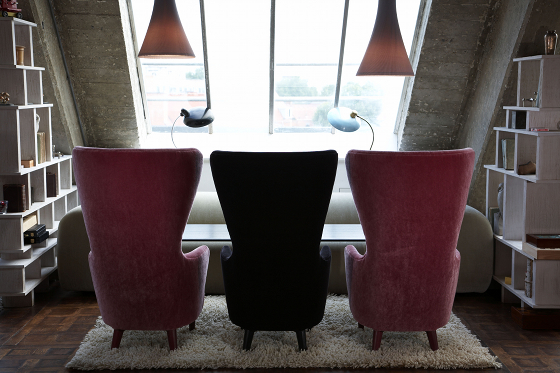
The Sitting Room at Shoreditch House (part of the Soho House chain) offers a considered environment for members who feel like working. Carefully selected furniture, like Tom Dixon's 'Wingback' chairs, provide privacy, while still allowing social contact
×This hasn't stopped a significant number of the workforce embracing a location-independent or location-multiple modus operandi, their 'office' being wherever they happen to be at any time. Such 'digital nomads', as they've come to be known, are nothing new. Just think of those lap-topping, latte-drinking dot-commers, installed in your local Starbucks in the late Nineties. And freelancers, in particular creatives such as graphic designers and writers, are no strangers to working from their kitchen tables and elsewhere. But greater wireless technology, together with a global financial downturn, has encouraged many more of us – those who can, that is – to exit traditional work environments in favour of freer agency. Remote working presents obvious cost benefits to companies who are looking for ways to cut overheads in recessionary times.
Swiss Airlines' award-winning first-class cabin, developed by renowned transport designers Priestman Goode, features generously sized desks for those passengers of a more industrious inclination

Swiss Airlines' award-winning first-class cabin, developed by renowned transport designers Priestman Goode, features generously sized desks for those passengers of a more industrious inclination
×But having the luxury of choosing where you work still involves making a decision about where you want to power up. The rise of the nomadic worker has precipitated the development of a number of interstitial spaces, neither home nor the office (nor Starbucks, for that matter), that are available to such operators to set up a temporary workspace. One such environment is the Soho House chain of exclusive private-members clubs, which effectively and creatively blurs the boundary between leisure and work.
Priestman Goode's Mercury concept train throws down the gauntlet to a British government that declares itself committed to a low-carbon future. The ability to work on board is built into the design
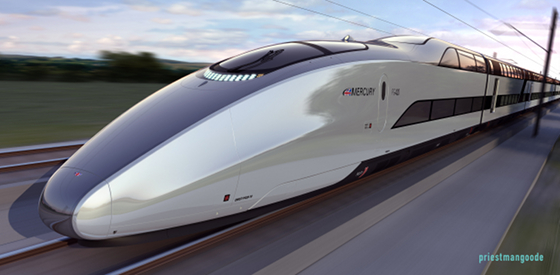
Priestman Goode's Mercury concept train throws down the gauntlet to a British government that declares itself committed to a low-carbon future. The ability to work on board is built into the design
×The original Soho House club in London was founded primarily for creative professionals from the film and media industries. With a specific professional group being targeted, the idea of work was built into the concept from the start. While its fine dining and two bars (serving cocktails, naturally) speak of large amounts of disposable income being spent in the name of down-time (with some networking thrown in), a number of meeting rooms and wireless internet connectivity throughout the building make the venue a nomadic worker's dream. Considering the fact that technology-charged mobile working has been particularly embraced by those in the creative industries, it's no wonder that Soho House has fashioned such a work-friendly space that looks in no way like an office.
The Mercury concept train's first-class interior. Private sound-proofed compartments throughout the train, which feature flat screens for business presentations, along with power sockets and WiFi, make the double-decker Mercury a digital nomad's paradise

The Mercury concept train's first-class interior. Private sound-proofed compartments throughout the train, which feature flat screens for business presentations, along with power sockets and WiFi, make the double-decker Mercury a digital nomad's paradise
×Soho House New York has taken the idea of the play/work environment further. Its 'Drawing Room', which features such design elements as a specially commissioned 39-foot-long Chesterfield sofa, Swarovski chandeliers and a pewter bar designed by Soho House founder and owner Nick Jones, is particularly popular with Manhattan's Very Important Persons, who like their workspace to look and feel nothing like a traditional one – and who possibly like to be seen working. A slew of diverse, and extremely comfortable, armchairs are married with a long, communal table, replete with iMacs for those who don't have their iPhone/Blackberry/laptop/other with them, encouraging conversation and the sharing of ideas. Overlooking 9th Avenue, the Drawing Room also serves breakfast, lunch and dinner – and, of course, cocktails.
Co-working space BCN Berlin provides free working agents with a place to drop in and power up. Free thinking also allowed.
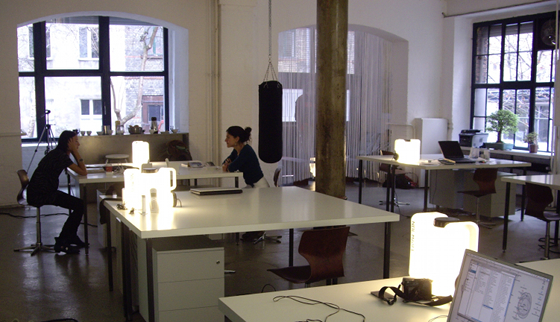
Co-working space BCN Berlin provides free working agents with a place to drop in and power up. Free thinking also allowed.
×Back in London, Shoreditch House, part of the Soho House project, also offers spaces for members to work (although with its bowling alley and roof-top pool, this club works hards to get you not to work). British designer Tom Dixon was drafted in to create a series of rooms that form a dialogue with the industrial past of the building's architecture. (The Tea Building, situated on Shoreditch High Street, is an early 20th-century warehouse that was refurbished by award-winning architects Allford Hall Monaghan Morris in 2004. Since then, it has been home to a number of creative agencies and production companies.) The 'Sitting Room', populated with Dixon's elongated wingback chairs, is once such space. It provides users with enough privacy to work, yet is designed to encourage social contact.
Members-only Paragraph in New York City was established as a co-working space for writers; photo Sarah Kell
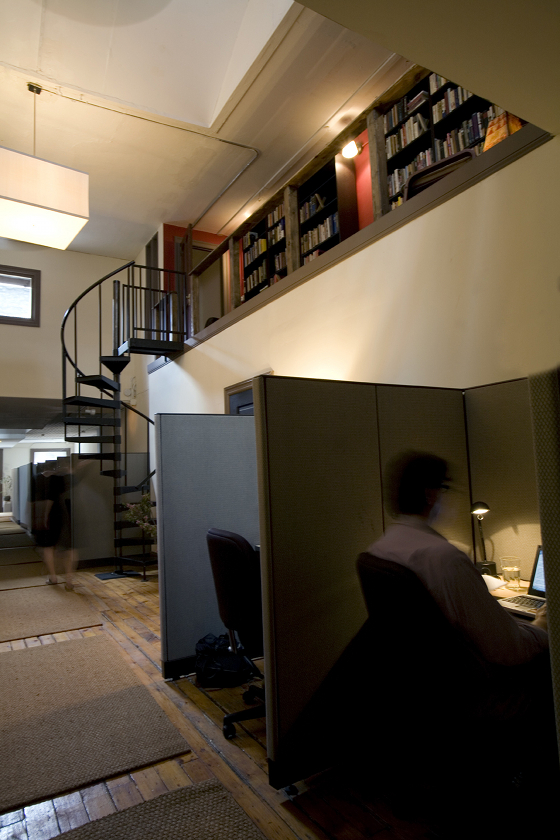
Members-only Paragraph in New York City was established as a co-working space for writers; photo Sarah Kell
×Transport designers have responded, too, to the mobility of working that digital-technology advances have allowed. Leading London-based transport and environment designers Priestman Goode have built the facility to work into several of their projects of late, truly amplifying the mobile aspect of digital nomadism. Their redesign of Swiss International Airline's first-class suite – which was awarded 'Best Transportation' at the Travel & Leisure Design Awards, judged by, among others, Terence Conran and Isaac Mizrahi – recognises that the type of passenger who elects to fly in such a rarefied environment isn't content merely with champagne, a large-screen television and a flat bed. Each of the spaces assigned to travellers also comes with a generously sized fold-away desk, as well as various ports and sockets for you plug into. The result is an effective workspace that lets you get the job done.
Berlin's ClubOffice by Business Alliance Center, with its restaurant, coffee shop and overnight accommodation, is particularly suited to those who want to feel right at home while at work
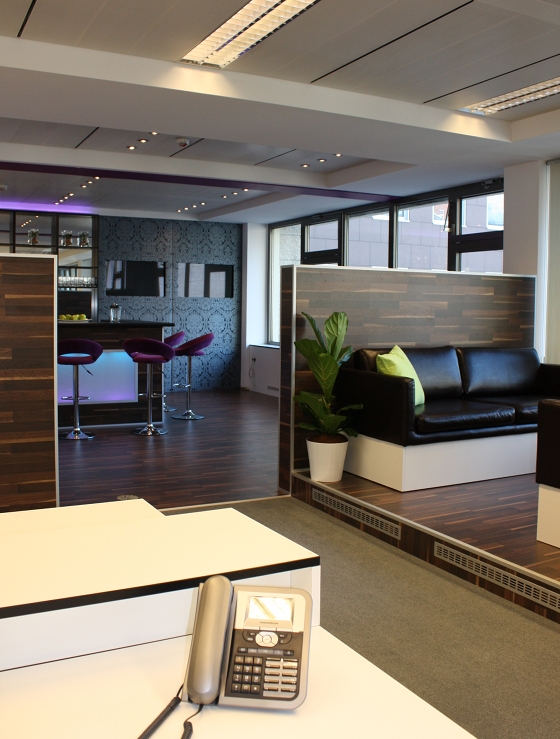
Berlin's ClubOffice by Business Alliance Center, with its restaurant, coffee shop and overnight accommodation, is particularly suited to those who want to feel right at home while at work
×But you don't have to take to the skies to enjoy (if that's the right word) work on the go. Priestman Goode's recently unveiled design concept for a new UK high-speed train, which lays down the gauntlet to a British government that claims to be committed to a low-carbon, sustainable approach to transport, could, according to designer Paul Priestman, become a national design icon in the vein of Concorde, Rolls Royce and the Routemaster bus. Having previously designed Virgin's Pendolino train, Priestman also believes the message that the Mercury project, if it were to be realised, would send globally about Britain's excellence in transport engineering would be loud and clear. The double-decker Mercury train's internal design takes mobile working seriously, moreover. Traditional commuter seats feature alongside sound-proofed private compartments, allowing business meetings to be held. Each compartment has a flat screen for presentations, with power sockets and WiFi throughout the train.
Reminiscent of a Joe Colombo design piece, Patricia Terrazas and Michael Svane's 'Four Works' armchair/desk/light/storage for Danish label Four Design provides a complete and independent workspace
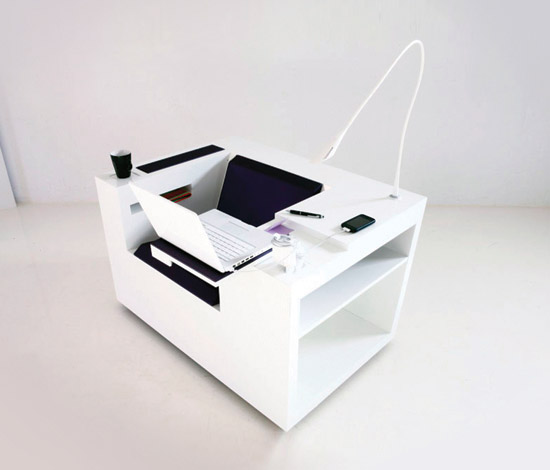
Reminiscent of a Joe Colombo design piece, Patricia Terrazas and Michael Svane's 'Four Works' armchair/desk/light/storage for Danish label Four Design provides a complete and independent workspace
×But what if you don't quite have the wherewithal to join a private-members club or travel in any class higher than economy? Well, digital nomads are banding together to create 'democratic' environments that allow like-minded, like-working individuals to drop in and share a physical space when they want and how they want. Co-working spaces, often open around the clock, began to appear in cities a couple of years ago, and, as a trend, continues to grow. Wireless technology has set us adrift in a rather exciting way, but also left some independent workers feeling like they're somewhat at sea. Man is, after all, a social animal and co-working responds to the need we often have to feel part of a group. The comfort of strangers, if you will. It's up to you, however, how much you interact with the other nomads who happen to be there at the same time. But for freelance creative professionals in particular, the main benefit of ad-hoc workspace sharing is clear: the circulation of ideas and the chance conversations that can happen in such places can provide valuable creative fodder.
Joep van Lieshout's highly expressive 'AVL Skull' for Dutch manufacturer Lensvelt delivers a semi-private, ad-hoc work environment, ideal for a contract setting

Joep van Lieshout's highly expressive 'AVL Skull' for Dutch manufacturer Lensvelt delivers a semi-private, ad-hoc work environment, ideal for a contract setting
×It shouldn't come as a surprise that Germany is one of the countries where co-working has found a committed user base. Pooling resources tends to be part of everyday life to a much larger extent than in the UK, say, or America. The mere notion of car-sharing, for example, tends to generate a distinct sense of uneasiness in a lot of British. BCN Berlin, however, which is located in the German capital's Kreuzberg district, known for its high number of creative residents, has succeeded in providing a bright, design-conscious environment (complete with punch-bag) for those who actually do like to rub shoulders with other free working agents. €15 secures a desk at BCN for a day. Chat with fellow nomads costs nothing, of course.
Matali Crasset's 'Open Room No. 1' for Established&Sons plays with architectural space to create an open, yet defined, flexible work environment
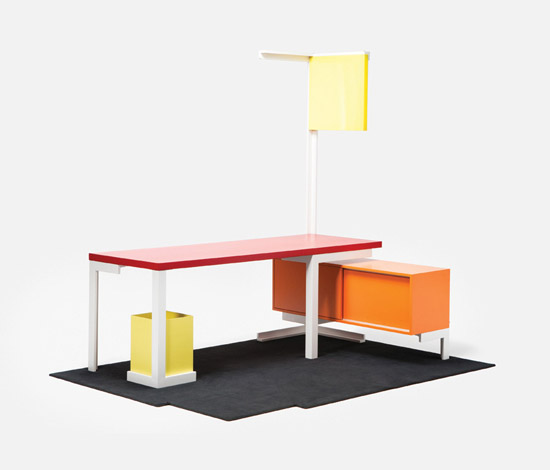
Matali Crasset's 'Open Room No. 1' for Established&Sons plays with architectural space to create an open, yet defined, flexible work environment
×Paragraph is a co-working space in New York, which, as the name might suggest, was set up specifically for freelance writers. The 2,500-square-foot loft space is divided into writing room (with library) and kitchen/lounge area. A stone's throw from Union Square and open 24 hours a day, all year round, this work space is members-only. Idea exchange is also part of the culture here, but do make sure you keep your voice down when doing so. People are writing. If you like your co-working space to be a little more corporate in feel, however, (and happen to be in Berlin) then maybe ClubOffice by Business Alliance Center is the place for you to hang out with your booted and suited peers. A restaurant and café, together with apartments for overnighting in, are designed to make you feel at home while at work.
Antonio Citterio's new 'Suita' sofa system for Vitra addresses the continued dissolution of boundaries between work and leisure spaces

Antonio Citterio's new 'Suita' sofa system for Vitra addresses the continued dissolution of boundaries between work and leisure spaces
×Furniture and product designers have also addressed the growing trend in location-plural working, creating pieces that help establish small-scale, stand-alone work environments within larger architectural spaces, but which are independent of them. Such products are ideal for nomads who drop by with their wireless gadgetry. Reminiscent of an integrated Joe Colombo design, like his Boby Trolley or his Minikitchen, Patricia Terrazas and Michael Svane's 'Four Works' armchair/desk/light/storage for Danish label Four Design provides a complete, independent workspace, which, obviously, lends itself to use in a contract context.
For nomads who like a little more privacy to their workspace, Joep van Lieshout's 'AVL Skull' for Dutch manufacturer Lensvelt delivers. Made of two polyester elements riveted together, the highly expressive form contains a solid-wood work surface and seat. An opening on one side allows entry into the pod, which, together with a 'port hole' on the other side, draws light into the enclosure. The design is particularly suited to tasks that require concentration.
Dutch design duo Kapteinbolt's collapsible 'FLKS' workspace, made of plywood and featuring a chair and desk that fold out, uses intersecting plans to suggest the overall limits the user's work environment

Dutch design duo Kapteinbolt's collapsible 'FLKS' workspace, made of plywood and featuring a chair and desk that fold out, uses intersecting plans to suggest the overall limits the user's work environment
×The idea of a defined workspace, but one that operates, conversely, through the idea of openness, is beautifully executed in Matali Crasset's 'Open Room No. 1' for British brand Established&Sons. First prototyped a number of years ago in a project funded by VIA, the Paris-based organisation that supports young French design, the unit establishes a 'room within a room', as it were, implying the overall boundaries of the user's workspace through its angular, highly architectural form. Blocks of colour denote the piece's different functions: desk, cupboard, lamp, rug.
Suggested architectural space, rather than real enclosed space, is also at work in Dutch design duo Kapteinbolt's collapsible workspace, 'FLKS'. Constructed of plywood, it features a chair and desk that fold out. Hinged joints mean that the entire unit can be folded flat for storage (which can be as simple as leaning it against the wall) when not in use. Walls, and by extension a sense of enclosure, are suggested by the vertical sheet elements of the design.
Tim Vinke's 'Het Kruikantoor' mobile office concept. Made of lightweight foam, the portable unit consists of two chairs, a desk, a light and storage that slot together, puzzle-like, to form a moveable trolley

Tim Vinke's 'Het Kruikantoor' mobile office concept. Made of lightweight foam, the portable unit consists of two chairs, a desk, a light and storage that slot together, puzzle-like, to form a moveable trolley
×Designer Tim Vinke imagines his mobile office's ideal user as 'a starting entrepreneur, without a fixed location'.
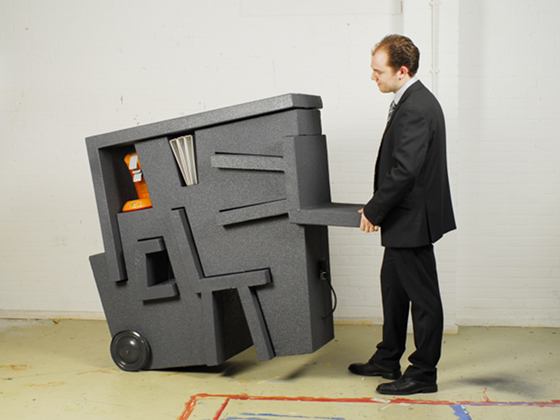
Designer Tim Vinke imagines his mobile office's ideal user as 'a starting entrepreneur, without a fixed location'.
×Vitra, who have a long tradition of manufacturing furniture for, among other environments, the office, have given a nod to work's increased mobility in their latest Antonio Citterio-designed 'Suita' sofa system. An optional desk/shelf, which is installed at the back of the sofa, extends the function of this familiar domestic object type beyond that of relaxation, creating a hybrid piece that allows users (and even multiple and simultaneous users) to work and to kick back.
But if you're looking to start out as a digital nomad and it's a leg-up you're after, then perhaps you should consider Tim Vinke's 'Het Kruikantoor' (a portmanteau of the Dutch for 'wheelbarrow' and 'office'), a design for a truly mobile office. 'A starting entrepreneur, without a fixed location' is how the designer imagines the project's ideal user. Made of lightweight foam, the portable unit consists of two chairs, a desk, a light and storage that slot together, puzzle-like, to form something akin to trolley, its wheels allowing it to be pushed and pull around easily. Vinke's work here is clearly whimsical to a certain extent, but it also makes a serious point, even if on the level of metaphor. You take the workspace of the future with you. In short, it's wherever you are.
.....














